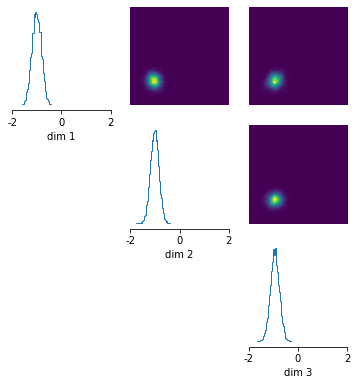Getting started with sbi¶
Note, you can find the original version of this notebook at https://github.com/sbi-dev/sbi/blob/main/tutorials/00_getting_started.ipynb in the sbi repository.
import torch
from sbi import analysis as analysis
from sbi import utils as utils
from sbi.inference.base import infer
Running the inference procedure¶
sbi provides a simple interface to run state-of-the-art algorithms for simulation-based inference.
For inference, you need to provide two ingredients:
1) a prior distribution that allows to sample parameter sets.
2) a simulator that takes parameter sets and produces simulation outputs.
For example, we can have a 3-dimensional parameter space with a uniform prior between [-1,1] and a simple simulator that for the sake of example adds 1.0 and some Gaussian noise to the parameter set:
num_dim = 3
prior = utils.BoxUniform(low=-2 * torch.ones(num_dim), high=2 * torch.ones(num_dim))
def simulator(parameter_set):
return 1.0 + parameter_set + torch.randn(parameter_set.shape) * 0.1
sbi can then run inference:
# Other methods are "SNLE" or "SNRE".
posterior = infer(simulator, prior, method="SNPE", num_simulations=1000)
# Using `init_kwargs`, `train_kwargs` and `build_posterior_kwargs`, you can also pass additional keyword arguments to `__init__`, `train` and `build_posterior` of the inference method. But we recommend to use the flexible interface which is introduced in a later tutorial.
Running 1000 simulations.: 0%| | 0/1000 [00:00<?, ?it/s]
Neural network successfully converged after 119 epochs.
Let’s say we have made some observation \(x\):
observation = torch.zeros(3)
Given this observation, we can then sample from the posterior \(p(\theta|x)\), evaluate its log-probability, or plot it.
samples = posterior.sample((10000,), x=observation)
log_probability = posterior.log_prob(samples, x=observation)
_ = analysis.pairplot(samples, limits=[[-2, 2], [-2, 2], [-2, 2]], figsize=(6, 6))
Drawing 10000 posterior samples: 0%| | 0/10000 [00:00<?, ?it/s]

Next steps¶
The single-line interface described above provides an easy entry for using sbi. However, on almost any real-world problem that goes beyond a simple demonstration, we strongly recommend using the flexible interface.